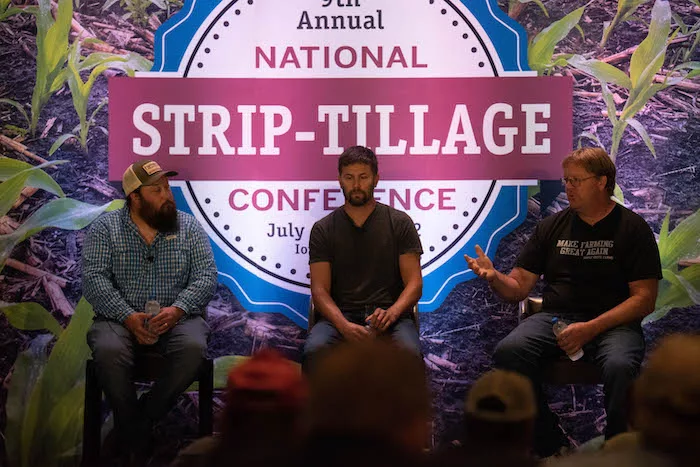Strip-tillers Jon Stevens of Rock Creek, Minn., Ryan Nell of Beaver Dam, Wis., and Ryan Shaw of Snover, Mich., fielded questions about their usage of cover crops during a panel discussion at the 2022 National Strip-Tillage Conference. Here are some highlights from the session.
Q: How long have you been using cover crops?
Shaw: I’d say about 15 years. We’re slowly getting into more blends. We do interseed our corn now. We’re starting to flirt with more of them and get more comfortable with the ones you don’t want to go to seed and become noxious and problematic.
Q: How do you make cover crops work with strip-till?
Nell: I think covers and strip-till are a perfect harmony. I really like having the cover crop in between my 30-inch rows, and I prefer not to have a cover crop touching my corner beans. We run an air seeder, and then we run a strip-till bar right behind it, so it’s two separate passes. It’s a great system, in my opinion.
Stevens: Anything with soil health works anywhere. It is just how to incorporate it into your operation. Cover crops and strip-till are great companions. We did not change anything to incorporate cover crops. No-till cover crops go into young corn with the broadcaster. Strip-till, go into young corn with the broadcaster. I can’t fathom or correlate how the strip-till ahead of planting has a reflect on a later cover crop application. Depending on cover crop species, goals, timings, things like that, you can run into some challenges, but it works. It works well.
Nell: Maybe if you’re spring stripping, I could see that as an issue. If you had cereal rye that maybe got a little out of hand and you’re trying to spring strip, I could definitely see that, you could run into an issue. But that’s a management thing and you just kind of have to see how the calendar might affect your situation. Maybe you need to terminate your cover crop a little earlier, rather than trying to strip-till it green.
Shaw: I don’t think anybody is doing anything wrong. It’s just a matter of adapting to what you’re seeding each year, because the environment or weather can throw loops into it. We found when we were seeding down solid-seeded cover crops, that if we were making false strips and applying the fertilizer, that we were ripping two perfect rows out. That’s why we use that inter seeder to apply all our fall cover crops outside of our zone that will over winter. And then if we have a spare tank on our Soil Warrior, we’ll put some winter kill stuff down, like some buckwheat or anything, to hold down the berm. Like they were saying cereal rye or annual rye that gets seeded over into your planting zone. One spring, we had trouble closing our slot because of mess of roots that were there.
Question: Hypothetically, if you were forced to get rid of strip-till or cover crops, which would you get rid of?
Stevens: Boy, that’s a tough one. I’d have a lot of crying nights. They’re both just wonderful tools. If I had to get rid of one of them, it would be the strip-till, because I know in time, I could get the cover crops to do the tillage work that I’m trying to do. And in the long term, the cover crops will do the fertility and everything else that they’re trying to do.
Nell: My cover crop would be gone right away. If you took a fall strip away from me, I’d be very disappointed.
Shaw: For me, I guess it would all depend on the acreage or the farm that I was dealing with at that time, or the field. If I wasn’t applying any nutrients or banding it down, I’d keep the cover crop.
Question: How important is flexibility in using cover crops? We have some folks who really want to push for farmers that get cost-share dollars for cover crops to have it on the same acreage every year to sort of build the soil health piece. But think about it from the perspective of when you’re starting and just, I want to hear from producers, how important is that flexibility to move cover crop acreage around, even if you’re pursuing some sort of funding?
Stevens: I think, with government programs, the flexibility of the program would be a big, important factor, because we have bad years, good years, things like that. If you sign into it with a permanent contract, you could have the debate that, if we’re getting into cover cropping and we’re moving that cover crop from field to field and never give that same spot the many years of cover crops it might take to heal that dead dirt and create functioning, living soil, we might be missing some opportunity. But at the same time, you would want a producer, who is learning, to be able to adapt to them the first couple years, to be like, “Okay, we tried it on that field, and we’re not quite understanding what’s going on, let’s go to this field” without losing that contract.
Shaw: I think there should be some flexibility in it, but I do see the reasoning behind wanting to follow the same track number. We won’t see the change in one year, but if you could do the multiple years in a row, you may start to see something change, but if it it’s a newcomer, you don’t want to put them in a position where they can’t be flexible enough and get a bad taste and abandon it. Because I think, with the programs, you want them to continue that even after the program is over, so kind of more leaning toward what works for their system. If it’s rotating to a different field, I think that they should be flexible with that.






